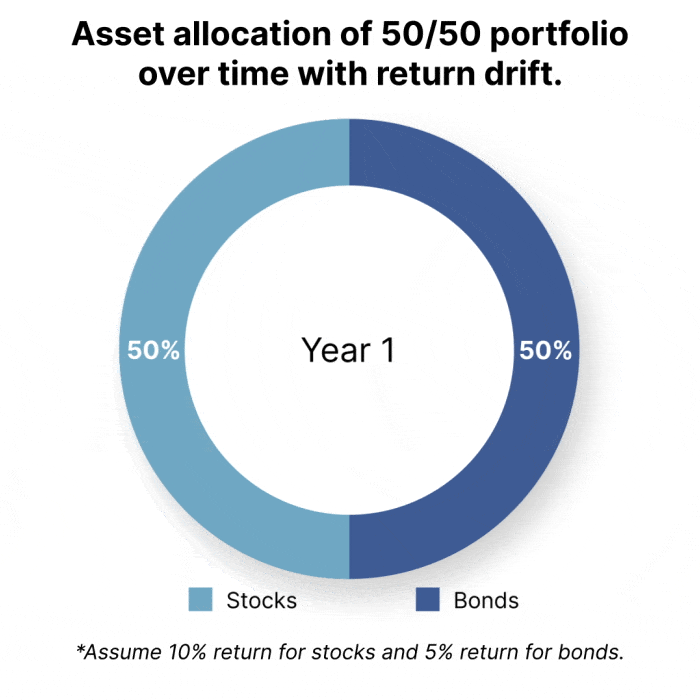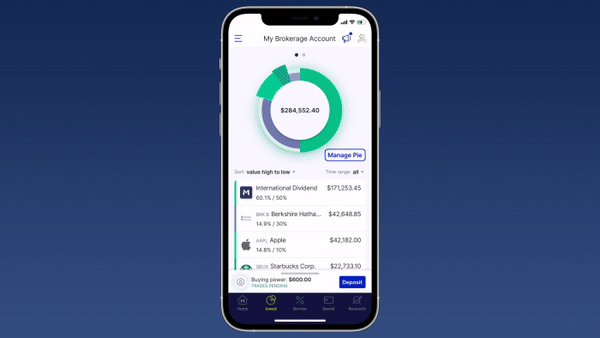How automatic rebalancing simplifies portfolio management

Automatic rebalancing keeps your investment portfolio in line with financial goals. Over time, some securities may earn more in returns or dividends while others lose value. This can result in a portfolio that no longer matches your target allocations nor your overall investment strategy. Rebalancing allows you to reallocate funds to keep your investment portfolio on track.
What is automatic rebalancing, and what are the benefits?
Automatic rebalancing is the process of bringing the investments in your portfolio back to your original target allocations to maintain the risk-return profile you initially set. Over time, certain securities in your portfolio may earn more in returns or dividends while others earn less. This can alter your overall asset allocation.
Let’s say your portfolio consists of two stocks, each set to 50% of your overall portfolio: Stock A and Stock B. Stock A is a growing tech stock with higher risk and higher potential for reward. Stock B is a blue-chip industrial stock with stable earnings — an investment with less potential for outsize returns.
Suppose that after one year, Stock A earned higher returns than Stock B and accounts for 60% of your overall portfolio. That means Stock B accounts for 40%.

Your risk-return profile has now shifted in favor of the riskier security. If you wish to keep your portfolio aligned with your portfolio goals and risk tolerance, you’ll want to rebalance to bring each stock back to 50% of your portfolio.
So why automatically rebalance your portfolio? Rebalancing keeps your portfolio on track and ensures it doesn’t skew toward too much risk or too little reward.

Rebalancing is a powerful tool that helps investors stay on track to meet their financial goals. But it’s not without pitfalls.
First, manual rebalancing can be time intensive. It requires investors to manually calculate each individual trade to bring each individual security back to its desired target weight in the overall portfolio.
Then there are the trades themselves. Depending on your brokerage, rebalancing may be costly. The more out of alignment your assets are, the more buy and sell orders you’ll need to place to bring them back to your targets — and the more trades you may need to pay commissions. And that’s not considering the tax consequences that come with placing many individual trades.
Frequent rebalancing may result in high costs that eat away at your returns. On the other hand, rebalancing too infrequently may skew your risk exposure. So, what’s the best strategy?
Calculating asset allocation risk
Choosing your investments is more than selecting stocks of companies with high growth potential, large dividend yields, or low price-to-earnings ratios.
When you select your investments, you not only choose which securities you own and how many shares you own of each, you also set each as a portion of your overall portfolio. As you do so, you inherently define your risk-return profile.
This is because some assets are inherently riskier than others, with greater potential for returns. Others carry less risk, but also provide less opportunity for larger returns. The securities you choose and the portion each accounts for in your overall portfolio should align with your investment goals and risk tolerance.
For example, an individual with high risk tolerance or long investment horizon may invest more money in stocks, while an individual with lower risk tolerance or a shorter timeline may invest a larger percent of their money in bonds. This same principle applies within asset classes, as well, with some stocks carrying more risk than others.
The targets you set for each security in your portfolio ultimately make up your asset allocation. In other words, if 70% of the money in your portfolio is invested in stocks and the other 30% is invested in bonds, your asset allocation is 70/30.
Any time you rebalance your portfolio you may initiate buys and sales of stocks.
Sales of securities may carry tax implications which you should always consider before making the decision to rebalance.
Common rebalancing strategies to reset your portfolio
Investors typically use one of two rebalancing strategies.
1. Time-based
Rebalancing occurs at a set time interval: once per month, quarter, or year. This provides an opportunity to check in on your portfolio, but it may not always fall at the ideal time.
For example, rebalancing too often may expose you to additional trade costs and taxes. Rebalancing too seldom may throw your risk-return ratio completely out of whack. That’s why consistent time-based rebalancing can be a bit arbitrary.
2. Drift-based
This means you rebalance your portfolio when your actual percentage for an asset drifts outside of a predetermined band, for example, 5% or more outside its target. Drift rebalancing reduces the likelihood of unnecessary rebalancing, but you still experience the adverse effects of rebalancing.
Automatic rebalancing simplifies portfolio management
Many investors use automatic rebalancing to maintain their target asset allocation, without the extra time and cash needed for frequent manual rebalancing.
Automatic rebalancing can take many forms, but it generally allows you to schedule or automate a rebalance of your portfolio without manually calculating and placing trades. This is typically done on a time- or drift-basis, with some platforms allowing investors to set intervals for rebalancing their portfolio. While this removes the time-intensive, manual calculations portion of the process, it maintains the arbitrary nature of time-based rebalancing. It also doesn’t help reduce your trade costs or taxes.
That’s why we decided to transform the rebalancing process. We call it Dynamic Rebalancing, and it’s seamlessly woven into M1’s intelligent automation. With this automatic rebalancing, you can reduce the time and cost of rebalancing and keep your portfolio on track.

Rather than setting a schedule for rebalancing, M1 intelligently and automatically rebalances your portfolio little by little as you deposit and withdraw cash from your portfolio. So, if one of your securities is underweight in relation to your target, more money will flow into that asset when you make a deposit.
The result? You skip manually calculating and placing trades, and you avoid the tax consequences of selling.
Every time you invest, you’re also balancing out your portfolio and bringing each investment closer to its target. And because rebalancing happens little by little with each deposit and withdrawal, your risk exposure stays more consistent over time, so you’re always invested exactly how you want.
- Categories
- Invest



